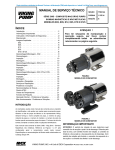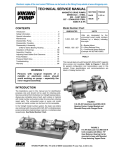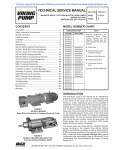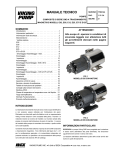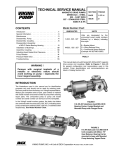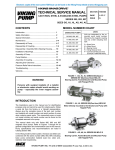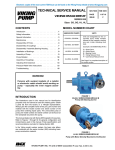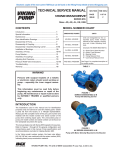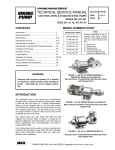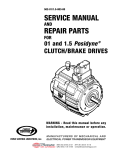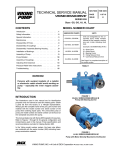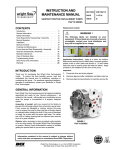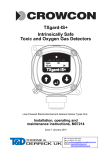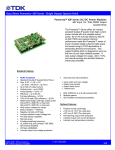Download TECHNICAL SERVICE MANUAL
Transcript
Electronic copies of the most current TSM issue can be found on the Viking Pump website at www.vikingpump.com TECHNICAL SERVICE MANUAL CMD SERIES COMPOSITE MAG DRIVE PUMPS MODELS E02, E05, E12, E25, E75 AND E125 CONTENTS Introduction . . . . . . . . . . . . . . . . . . . . . . . .1 Special Information . . . . . . . . . . . . . . . . . . . .1 Safety Information . . . . . . . . . . . . . . . . . . . . 2 Maintenance . . . . . . . . . . . . . . . . . . . . . . .3 Exploded Views . . . . . . . . . . . . . . . . . . . . . 4 E02 . . . . . . . . . . . . . . . . . . . . . . . . . . .4 E05 . . . . . . . . . . . . . . . . . . . . . . . . . . .5 E12 . . . . . . . . . . . . . . . . . . . . . . . . . . .6 E25 . . . . . . . . . . . . . . . . . . . . . . . . . . .7 E75 and E125 . . . . . . . . . . . . . . . . . . . . .8 Disassembly/Assembly - E02 . . . . . . . . . . . . . . 9 Disassembly . . . . . . . . . . . . . . . . . . . . . .9 Inspection . . . . . . . . . . . . . . . . . . . . . . 10 Assembly . . . . . . . . . . . . . . . . . . . . . . .10 Disassembly/Assembly - E05 and E12 . . . . . . . . . 12 Disassembly . . . . . . . . . . . . . . . . . . . . . 12 Inspection . . . . . . . . . . . . . . . . . . . . . . 13 Assembly . . . . . . . . . . . . . . . . . . . . . . .13 Disassembly/Assembly - E25, E75 and E125 . . . . . 15 Disassembly . . . . . . . . . . . . . . . . . . . . . 15 Inspection . . . . . . . . . . . . . . . . . . . . . . 16 Assembly . . . . . . . . . . . . . . . . . . . . . . .16 Inspection and Wear Limits . . . . . . . . . . . . . . 18 Service and Replacement Limits . . . . . . . . . . . . 18 Troubleshooting Chart . . . . . . . . . . . . . . . . . 19 Bolt Torque Recommendations . . . . . . . . . . . . . 20 ATEX Directive . . . . . . . . . . . . . . . . . . . . . 21 Temperature Class and Max. Liquid Temperatures . . 21 Sample Tag . . . . . . . . . . . . . . . . . . . . . . . 22 Normal Operation . . . . . . . . . . . . . . . . . . . 23 Expected Malfunction . . . . . . . . . . . . . . . . . 23 SECTION TSM 344 PAGE 1 OF 24 ISSUE G ATTENTION ! To ensure safe handling and operating situations, please thoroughly review all of the warnings listed on the following page. FIGURE 1 MODEL E05 WITH MOTOR INTRODUCTION The illustrations used in this manual are for identification purposes only and cannot be used for ordering parts. Obtain a parts list from the factory or a Viking representative. Always give a complete name of the part, part number and material with the model number and serial number of pump when ordering repair parts. The unmounted pump or pump unit model number and serial number are on the nameplate. This manual deals only with CMD Series Composite Mag Drive Pumps. Refer to Figures 1 through 47 for general configuration and nomenclature used in this manual. Pump specifications and recommendations are listed in Catalog Section 344. FIGURE 2 MODEL E25 WITH MOTOR SPECIAL INFORMATION ROTATION: Shaft rotation determines which port is suction and which is discharge. Viewed from shaft end, with clockwise rotation, the right port is suction and left port is discharge. With counterclockwise rotation, the left port is suction and right port is discharge. VIKING PUMP, INC. • A Unit of IDEX Corporation • Cedar Falls, IA 50613 USA SAFETY INFORMATION INCORRECT INSTALLATION, OPERATION OR MAINTENANCE OF EQUIPMENT MAY CAUSE SEVERE PERSONAL INJURY OR DEATH AND/OR EQUIPMENT DAMAGE AND MAY INVALIDATE THE WARRANTY. This information must be read fully before beginning installation, operation or maintenance and must be kept with the pump. All installation and maintenance must be undertaken by suitably trained or qualified persons only. Symbol Legend : ! ! Danger - Failure to follow the listed precautionary measures identified by this symbol may result in serious injury or death. DO NOT OPERATE PUMP IF: – The front cover is not installed correctly. WARNING WARNING – Any guards are missing or incorrectly installed. – The suction or discharge piping is not connected. ! DO NOT place fingers, etc. into the pumping chamber or its connection ports or into any part of the drive train if there is ANY possibility of the pump shafts being rotated. Severe injury will occur. ! DO NOT exceed the pumps rated pressure, speed, and temperature, or change the system/duty parameters from those for which the pump was originally supplied, without confirming its suitability for the new duty. ! INSTALLATION AND OPERATION OF THE PUMP MUST ALWAYS COMPLY WITH HEALTH AND SAFETY REGULATIONS. ! Rare earth magnets used in couplings have extremely strong magnetic fields capable of changing performance or damaging items such as: Pacemakers, Metal Implants, Watches, Computers & Disks, and Credit Cards WARNING WARNING WARNING ! ! ! ! A device must be incorporated into the pump, system, or drive to prevent the pump exceeding its stated duty pressure. It must be suitable for both directions of pump rotation where applicable. Do not allow pump to operate with a closed/blocked discharge unless a pressure relief device is incorporated. If an integral relief valve is incorporated into the pump, do not allow re-circulation through the relief valve for extended periods. The mounting of the pump or pump unit should be solid and stable. Pump orientation must be considered in relation to drainage requirements. Once mounted, shaft drive elements must be checked for correct alignment. Rotate pump shaft by at least one full revolution to ensure smoothness of operation. Incorrect alignment will produce excessive loadings and will create high temperatures and increased noise emissions. Do not use any drive arrangements which cause sideloading of the drive shaft. The installation must allow safe routine maintenance and inspection (to check for leakage, monitor pressures, etc) and provide adequate ventilation necessary to prevent overheating. ISSUE G PAGE 2 OF 24 DO NOT INSTALL THE PUMP INTO A SYSTEM WHERE IT WILL RUN DRY (I.E. WITHOUT A SUPPLY OF PUMPED MEDIA). Pressure gauges/sensors are recommended, next to the pump suction and discharge connections to monitor pressures. Caution must be taken when lifting the pump. Suitable lifting devices should be used as appropriate. Lifting eyes installed on the pump must only be used to lift the pump, not pump with drive and/or baseplate. If pump is baseplate mounted, the base plate must be used for all lifting purposes. If slings are used for lifting, they must be safely and securely attached. For weights of bare shaft pumps refer to catalog. DO NOT attempt any maintenance or disassembly of the pump or pump unit without first ensuring that : – The pump is fully isolated from the power source (electric, hydraulic, pneumatic). –The pumping chamber, relief valve and any shaft seal support system are depressurized and purged. – Any temperature control devices (jackets, heattracing, etc) are fully isolated, that they are depressurized and purged, and components are allowed to reach a safe handling temperature. ! ! ! ! SECTION TSM 344 Before operating the pump, be sure that it and all parts of the system to which it is connected are clean and free from debris and that all valves in the suction and discharge pipelines are fully opened. Ensure that all piping connecting to the pump is fully supported and correctly aligned with its relevant connections. Misalignment and/or excess loads will cause severe pump damage. Be sure that pump rotation is correct for the desired direction of flow. Completely assembled magnetic couplings will not affect items listed above - only disassembled components. There are no known harmful effects of these magnetic fields on the human body. Warning - Safety instructions which shall be considered for reasons of safe operation of the pump or pump unit and/ or protection of the pump or pump unit itself are marked by this symbol. DO NOT attempt to dismantle a pressure relief valve which has not had the spring pressure relieved or is mounted on a pump that is operating. Serious personal injury or death and/or pump damage may occur. DO NOT loosen or undo the front cover, any connections to the pump, shaft seal housings, temperature control devices, or other components, until sure that such action will not allow the unsafe escape of any pressurized media. Pumps and/or drives can produce sound power levels exceeding 85 dB(A) under certain operating conditions. When necessary, personal protection against noise must be taken. Avoid any contact with hot parts of pumps and/or drives which may cause injury. Certain operating conditions, temperature control devices (jackets, heattracing, etc.), bad installation, or poor maintenance can all promote high temperatures on pumps and/or drives. SPECIAL INFORMATION (CONT’D) DANGER ! PRESSURE RELIEF VALVES: 1. Viking pumps are positive displacement pumps and must be provided with some sort of pressure protection. This may be an inline pressure relief valve, a torquelimiting device, or a rupture disk, or other method. NOTE: Pump can be operated in reverse direction for short duration at low differential pressure to clean/flush out lines. 2. If pump rotation is to be reversed during operation, pressure protection must be provided on both sides of the pump. 3. Pressure relief valves cannot be used to control pump flow or regulate discharge pressure. For additional information on pressure relief valves, refer to Technical Service Manual TSM000 and Engineering Service Bulletin ESB-31. MAINTENANCE Series CMD pumps are designed for long, trouble-free service life under a wide variety of application conditions with a minimum of maintenance. The following points will help provide long service life. Pumps that are mounted directly to the motor will need to be removed from the mounting bracket to perform mechanical seal maintenance or replacement. CLEANING PUMP: Keep the pump as clean as possible. This will facilitate inspection, adjustment, and repair work. Before opening any Viking pump liquid chamber (pumping chamber, reservoir, relief valve adjusting cap fitting, etc.) Be sure: 1. That any pressure in the chamber has been completely vented through the suction or discharge lines or other appropriate openings or connections. 2.That the driving means (motor, turbine, engine, etc.) has been “locked out” or made non-operational so that it cannot be started while work is being done on pump. 3.That you know what liquid the pump has been handling and the precautions necessary to safely handle the liquid. Obtain a material safety data sheet (MSDS) for the liquid to be sure these precautions are understood. Failure to follow above listed precautionary measures may result in serious injury or death. STORAGE: If pump is to be stored, or not used for six months or more, the pump must be drained and a light coat of light oil must be applied to all internal pump parts. Apply grease to the pump shaft extension. Viking suggests rotating pump shaft by hand one complete revolution every 30 days to circulate the oil. Tighten all pump assembly bolts before putting the pump in service after being stored. CMD - Series: Composite Mag Drive E02 Model: E02 E05 E12 * E25 * E75 * E125 * E L V F - X Materials/Ports: O-Rings: Options: E = ETFE, FNPT (E02, E05, E12) V=Viton® A = Bearing Flush Ports E=EPDM B = Combination of Options A and N B = ETFE, ISO 7-1 (E02, E05, E12) F = ETFE, Flange (E25, E75, E125) Bearings: L = Carbon Graphite B=Graphite-Impregnated Silicon-Carbide * Export license required under U.S. Export Administration ECCN 28350 and 28999. N = Without Drive Magnet X = Complete Pump (No Options) Mounting Arrangement: F = NEMA 56C (E02, E05, E12, E25) O = NEMA 143TC-182C (E05, E12, E25, E75, E125) R = NEMA 182TC-184TC (E75, E125) H = IEC B34 63 (E02, E05, E12) K = IEC B34 80 (E02, E05, E12) P = IEC B14 100/112 (E25, E75, E125) Y = No Motor Mount Kit (E02, E05, E12, E25, E75, E125) Viton® is a registered trademark of DuPont Performance Elastomers. SECTION TSM 344 ISSUE G PAGE 3 OF 24 E02 EXPLODED VIEW OF E02 PUMP (TYPICAL) Item Description Item 2 Drive Screw 13 Drive Gear Assembly * 23 Washer 3 Bolts 14 Center Housing 24 Drive Magnet 4 Washers 15 O-Ring, Containment Canister * 25 Coupling Hub 5 Front Cover 16 Bolts 26 Set Screw 6 O-Ring, Cover * 17 Washers 27 Screws 7 Bolts 18 Adapter, Canister 29 Bolts 9 O-Ring, Compression * 19 Containment Canister 30 Washer 10 Bearing * 20 Adapter, Spool 31 Adapter, Motor 11 Housing Liner * 21 Driven Magnet Assembly 12 Idler Gear Assembly * 22 Bolts * Recommended spare parts. SECTION TSM 344 ISSUE G PAGE 4 OF 24 Description Item Description E05 EXPLODED VIEW OF E05 PUMP (TYPICAL) Item Description Item Item Description 2 Drive Screw 14 Description Center Housing 25 Coupling Hub 3 Bolts 15 O-Ring, Containment Canister * 26 Set Screw 4 Washers 16 Bolts 27 Screws 5 Front Cover 17 Washers 28 Nut Plate 6 O-Ring, Cover * 19 Containment Canister 29 Bolts 9 O-Ring, Compression * 20 Adapter, Spool 30 Washer 10 Bearing * 21 Driven Magnet Assembly 31 Adapter, Motor 11 Housing Liner * 22 Bolts 32 Retaining Plate 12 Idler Gear Assembly * 23 Washer 33 O-Ring, Drain Plug * 13 Drive Gear Assembly * 24 Drive Magnet 34 Drain Plug * Recommended spare parts. SECTION TSM 344 ISSUE G PAGE 5 OF 24 E12 EXPLODED VIEW OF E12 PUMP (TYPICAL) Item Description Item 2 Drive Screw 14 3 Bolts 4 5 Description Item Description Center Housing 25 Coupling Hub 15 O-Ring, Containment Canister * 26 Set Screw Washers 16 Bolts 27 Screws Front Cover 17 Washers 28 Nut Plate 6 O-Ring, Cover * 19 Containment Canister 29 Bolts 9 O-Ring, Compression * 20 Adapter, Spool 30 Washer 10 Bearing * 21 Driven Magnet Assembly 31 Adapter, Motor 11 Housing Liner * 22 Bolts 32 Retaining Plate 12 Idler Gear Assembly * 23 Washer 33 O-Ring, Drain Plug * 13 Drive Gear Assembly * 24 Drive Magnet 34 Drain Plug * Recommended spare parts. SECTION TSM 344 ISSUE G PAGE 6 OF 24 E25 EXPLODED VIEW OF E25 PUMP (TYPICAL) Item Description Item Description Item Description 2 Drive Screw 16 Bolts 28 Nut Plates 3 Bolts 17 Washers 29 Bolts 4 Washers 18 Adapter, Motor 30 Washer 5 Front Cover 19 Containment Canister 31 Flange Gaskets 6 O-Ring, Cover * 20 Adapter, Spool 32 Mounting Base 9 O-Ring, Compression * 21 Driven Magnet Assembly 33 Bolt 10 Bearing * 22 Bolt 34 Washer 11 Housing Liner * 23 Washer 35 Retaining Plate 12 Idler Gear Assembly * 24 Drive Magnet 36 O-Ring, Drain Plug * 13 Drive Gear Assembly * 25 Coupling Hub 37 Drain Plug 14 Center Housing Flange 26 Set Screw 15 O-Ring, Containment Canister * 27 Screws * Recommended spare parts. SECTION TSM 344 ISSUE G PAGE 7 OF 24 E75 AND E125 EXPLODED VIEW OF E75 AND E125 PUMPS (TYPICAL) Item Description Item Description Item Description 2 Drive Screw 16 Bolts 28 Nut Plates 3 Bolts 17 Washers 29 Bolts 4 Washers 18 Adapter, Motor 30 Washer 5 Front Cover 19 Containment Canister 31 Flange Gaskets 6 O-Ring, Cover * 20 Adapter, Spool 32 Mounting Base 9 O-Ring, Compression * 21 Driven Magnet Assembly 33 Bolt 10 Bearing * 22 Bolt 34 Washer 11 Housing Liner * 23 Washer 35 Retaining Plate 12 Idler Gear Assembly * 24 Drive Magnet 36 O-Ring, Drain Plug * 13 Drive Gear Assembly * 25 Coupling Hub 37 Drain Plug 14 Center Housing Flange 26 Set Screw 15 O-Ring, Containment Canister * 27 Screws * Recommended spare parts. SECTION TSM 344 ISSUE G PAGE 8 OF 24 DISASSEMBLY / ASSEMBLY E02 WARNING ! 2. Place the pump assembly (motor spool down) on the work surface. 3. Remove the six bolts and flat washers (items 3, 4) and remove the front cover (item 5) as shown. Before performing any maintenance requiring pump disassembly, be sure to relieve pressure from the piping system and, where hazardous process materials are involved, render the pump safe to personnel and the environment by cleaning and chemically neutralizing as appropriate. Wear protective clothing and equipment as appropriate. CAUTION ! Rare earth magnets used in couplings have extremely strong magnetic fields capable of changing performance or damaging items such as the following: Pacemakers Metal Implants Watches Computers & Disks Credit Cards FIGURE 5 4. Remove the bearings (item 10), gear/shaft assemblies (items 12, 13) and housing liner (item 11) as shown. These parts, along with the three O-Rings make up a standard CMD Series repair kit. Check the parts for wear and replace with a repair kit as required. Completely assembled magnetic couplings will not affect items listed above - only disassembled components. There are no known harmful effects of these magnetic fields on the human body. FIGURE 6 DISASSEMBLY 5. Remove the two remaining bolts (item 7) to detach the center housing (item 14). ■ ■ ■ ■ ■ 6. Remove all O-Rings from the center housing and front cover. There are two in the center housing (items 6 and 15) and one in the front cover (item 9) as shown. Close all suction and discharge valves. Disconnect the power source to the motor. Flush and drain the pump. Remove the piping (optional for repair kit). NOTE: The canister area will not fully drain and will contain some process fluid. 1. Remove the four motor bolts and washers (items 22, 23) and slide the entire pump straight off the motor. FIGURE 7 FIGURE 4 7. Remove the eight mounting bolts and washers (items 16, 17) holding the adapter plate (item 18) to the motor spool (item 20) and detach the adapter plate. SECTION TSM 344 ISSUE G PAGE 9 OF 24 CAUTION ! Once the magnets are removed from the bracket, be careful setting them down, as they will attract any iron object. 4. Inspect and remove any debris or foreign materials that may have attached to the magnet. Install the driven magnet assembly (item 21) into the containment canister. The driven magnet is symmetrical and can be inserted with either end facing out (orientation does not matter). 8. Remove the driven magnet assembly (item 21) and containment canister (item 19) from the adapter plate as shown. FIGURE 10 5. Inspect all O-Rings to be sure there is no damage such as pinching prior to assembly. FIGURE 8 9. Remove the drive magnet assembly (item 24) from the motor by loosening the setscrew (item 26) in the magnet hub and slide off the motor shaft. Retain the key from the motor shaft. 6. Install O-Rings (items 6, 15) into grooves on both sides of the center housing. Some O-Ring lubricant may help keep the O-Rings in place during assembly. Be sure both O-Rings are fully seated into housing grooves. 10.If required, the magnet hub (item 25) canister be separated from the drive magnet (item 24) by removing the four screws (item 27) and detaching. FIGURE 11 FIGURE 9 INSPECTION Refer to Inspection and Wear Limits, page 18 for details. ASSEMBLY 7. Place the center housing (item 14) with O-Rings installed onto the spool adapter plate (open bore facing out), aligning the flat sides on the center housing to the flat sides on the spool adapter plate as shown. If the center housing does not sit flat, rotate 180º until it seats into place. 8. Secure the center housing using 2 bolts (item 7) in holes as shown. Tighten these bolts to the torque specified on page 20. Always tighten fasteners in a progressive “crisscross” pattern. 1.Place the motor spool (item 20) flat on the work surface. Align “molded-in” flats on the spool adapter plate (item 18) with any two of the motor mounting bolt holes on the motor spool as shown. 2. Set in place and install eight mounting bolts and washers (items 16, 17). Tighten these bolts to the torque specified on page 20. Always tighten fasteners in a progressive “crisscross” pattern. 3. Install the containment canister (item 19) into the spool adapter plate until it is properly seated into the assembly. SECTION TSM 344 ISSUE G PAGE 10 OF 24 FIGURE 12 9. Insert a bearing (item 10) into the center housing (item 14) and slide to the bottom of the housing. Bearings are symmetrical and orientation does not matter. 10. Install the housing liner (item 11) and slide until it seats against the first bearing. Install the idler gear (item 12) into the top hole in the bearing until the gear seats against the first bearing. 15. For IEC frame motors only, if it was removed, install the motor adaptor plate (item 31) onto the motor face using the four bolts and washers (items 29 and 30). Always tighten fasteners in a progressive “crisscross” pattern. 11. Install the drive gear (item 13), splined-end first, into the assembly until it bottoms out against the bearing. The shaft may have to be rotated slightly to properly fit the splined-end into the drive magnet and gear to the idler gear assembly. 12.Insert the second bearing (item 10) into the housing bore until it rests against the housing liner. Bearings are symmetrical and orientation does not matter. FIGURE 16 16. Secure the magnet hub (item 25) to the drive magnet (item 24) using the four screws (item 27). Always tighten fasteners in a progressive “crisscross” pattern. FIGURE 13 13. Install the spacer O-Ring (item 9) into the front cover as shown. Some O-Ring lubricant may help keep the O-Rings in place during assembly. FIGURE 14 14. Install the front cover with spacer O-Ring using the six bolts and washers. Tighten these bolts to the torque specified on page 20. Always tighten fasteners in a progressive “crisscross” pattern. FIGURE 15 FIGURE 17 17. Align the keyway, and slide the drive magnet onto the motor shaft until the end of the motor shaft aligns with faces of the drive magnet motor hub, as shown below. Secure with the setscrew (item 26). Application of a noseize compound on the shaft and key will make future maintenance easier. 18.Complete the assembly by replacing the assembled pump onto the motor, using care not to allow fingers to get pinched when the magnets attract. Secure the pump to the motor with the four bolts and washers (items 22, 23). Always tighten fasteners in a progressive “crisscross” pattern. FIGURE 18 SECTION TSM 344 ISSUE G PAGE 11 OF 24 DISASSEMBLY / ASSEMBLY E05 AND E12 WARNING ! 2. Place the pump assembly (motor spool down) on the work surface. 3. Remove the six bolts and washers (items 3, 4), remove front cover (item 5) and nut plates (item 28) as shown. Before performing any maintenance requiring pump disassembly, be sure to relieve pressure from the piping system and, where hazardous process materials are involved, render the pump safe to personnel and the environment by cleaning and chemically neutralizing as appropriate. Wear protective clothing and equipment as appropriate. CAUTION ! Rare earth magnets used in couplings have extremely strong magnetic fields capable of changing performance or damaging items such as the following: FIGURE 20 4. Remove the bearings (item 10), gear/shaft assemblies (items 12, 13) and housing liner (item 11) as shown. These parts, along with the four O-Rings make up a standard CMD Series repair kit. Check parts for wear and replace with a repair kit as required. Pacemakers Metal Implants Watches Computers & Disks Credit Cards Completely assembled magnetic couplings will not affect items listed above - only disassembled components. There are no known harmful effects of these magnetic fields on the human body. DISASSEMBLY ■ ■ ■ ■ ■ Close all suction and discharge valves. Disconnect power source to motor. Flush and drain pump. Remove piping (optional for repair kit). NOTE: The can area will not fully drain and will contain some process fluid. FIGURE 21 5. Remove the eight mounting bolts and washers (items 16, 17) holding the center housing (item 14) to the motor spool (item 20). Remove the center housing and retaining plates (item 32). 6. Remove all O-Rings from the center housing and front cover. There are two O-Rings in the center housing (items 6, 15) and one in the front cover (item 9) as shown. 1. Remove the four motor bolts and washers (items 22, 23) and slide the entire pump straight off the motor. FIGURE 19 SECTION TSM 344 ISSUE G PAGE 12 OF 24 FIGURE 22 CAUTION ! Once the magnets are removed from the bracket, be careful setting them down, as they will attract any iron object. 7. Remove the driven magnet assembly (item 21) and containment canister (item 19) from the motor spool (item 20) as shown. FIGURE 25 3. Inspect all O-Rings to be sure there is no damage such as pinching prior to assembly. FIGURE 23 8. Remove the drive magnet assembly from the motor by loosening the setscrew (item 26) in the magnet hub (item 25) and slide off the motor shaft. Retain the key from the motor shaft. 9. If required, the magnet hub (item 25) can be separated from the drive magnet (item 24) by removing the four screws (item 27) and detaching. FIGURE 26 4. Install O-Rings (items 6, 15) into each side of the center housing (item 14) as shown. Some O-Ring lubricant may help keep the O-Rings in place during assembly. Be sure both O-Rings are fully seated into housing grooves. 5. Place the center housing, with O-Rings, onto the motor spool, aligning the port connections between any set of motor spool bolt holes as shown. Add the retaining plates (item 32). Secure with eight bolts and washers (items 16, 17). Tighten these bolts to the torque specified on page 20. Always tighten fasteners in a progressive “crisscross” pattern. FIGURE 24 INSPECTION Refer to Inspection and Wear Limits, page 18 for details. ASSEMBLY 1. Place the motor spool (item 20) flat on the work surface. 2. Insert the containment canister (item 19) and driven magnet (item 21) into the motor spool as shown. The driven magnet is symmetrical and orientation does not matter. FIGURE 27 6. Insert a bearing (item 10) into the center housing and slide to bottom of bore. Bearings are symmetrical and orientation does not matter. Install the housing liner (item 11) and slide until it seats against the first bearing. Install the idler gear (item 12) into the top hole in the bearing until the gear seats against the first bearing. SECTION TSM 344 ISSUE G PAGE 13 OF 24 7. Install the drive gear (item 13), splined-end first, into the assembly until it bottoms out against the bearing. The shaft may have to be rotated slightly to properly fit the splined-end into the drive magnet and mesh gear teeth with the idler gear. 8. Insert the second bearing (item 10) into the housing bore until it rests against the housing liner. Bearings are symmetrical and orientation does not matter. FIGURE 31 12. Secure the magnet hub (item 25) to the drive magnet (item 24) using the four screws (item 27). Always tighten fasteners in a progressive “crisscross” pattern. FIGURE 28 9. Install the spacer O-Ring (item 9) into the front cover (item 5) as shown. Some O-Ring lubricant may help keep the O-Rings in place during assembly. FIGURE 32 13. Inspect and remove any debris or foreign materials that may have attached to the magnet. FIGURE 29 10.Place the front cover (item 5) with O-Ring onto the assembled pump. Secure the front cover using the six bolts and washers (items 3, 4) and two nut plates (item 28) as shown. The flat side of the nut plates mate against the back of the center housing flange. Tighten these bolts to the torque specified on page 20. Always tighten fasteners in a progressive “crisscross” pattern. Align the keyway, and slide the drive magnet onto the motor shaft until the end of the motor shaft aligns with faces of the drive magnet motor hub as shown below. Secure with the setscrew (item 26). Application of a noseize compound on the shaft and key will make future maintenance easier. 14.Complete the assembly by replacing the assembled pump onto the motor, using care not to allow fingers to get pinched when the magnets attract. Secure the pump to the motor with the four bolts and washers (items 22, 23). Always tighten fasteners in a progressive “crisscross” pattern. FIGURE 30 11. For IEC frame motors only, if it was removed, install the motor adaptor plate (item 31) onto the motor face using the four bolts and washers (items 29 and 30). Always tighten fasteners in a progressive “crisscross” pattern. SECTION TSM 344 ISSUE G PAGE 14 OF 24 FIGURE 33 DISASSEMBLY / ASSEMBLY E25, E75 AND E125 WARNING ! Before performing any maintenance requiring pump disassembly, be sure to relieve pressure from the piping system and, where hazardous process materials are involved, render the pump safe to personnel and the environment by cleaning and chemically neutralizing as appropriate. Wear protective clothing and equipment as appropriate. 2. Place the pump assembly (motor spool down) on the work surface. 3. Remove the six bolts and washers (items 3, 4), remove front cover (item 5) and nut plates (item 28) as shown. 4. If required, the mounting base (item 32) can be detached by removing the four bolts and washers (items 33, 34) as shown. CAUTION ! Rare earth magnets used in couplings have extremely strong magnetic fields capable of changing performance or damaging items such as the following: Pacemakers Metal Implants Watches Computers & Disks Credit Cards FIGURE 35 5.Remove the bearings (item 10), gear/shaft assemblies (items 12, 13) and housing liner (item 11) as shown. These parts, along with the four O-Rings make up a standard CMD Series repair parts kit. Check parts for wear and replace with a repair kit as required. Completely assembled magnetic couplings will not affect items listed above - only disassembled components. There are no known harmful effects of these magnetic fields on the human body. DISASSEMBLY ■ ■ ■ ■ ■ Close all suction and discharge valves. Disconnect power source to motor. Flush and drain pump. Remove piping (optional for repair kit). NOTE: The canister area will not fully drain and will contain some process fluid. 1. Remove the four motor bolts and washers (items 22, 23) and slide the entire pump straight off the motor. FIGURE 34 FIGURE 36 6. Remove the eight mounting bolts and washers (items 16, 17) holding the center housing (item 14) to the motor spool (item 20). Detach the center housing and retaining plates (item 35). 7. Remove all O-Rings from the center housing and front cover. There is one O-Ring in the center housing (item 15) and two in the front cover (items 6, 9) as shown. FIGURE 37 SECTION TSM 344 ISSUE G PAGE 15 OF 24 CAUTION ! Once the magnets are removed from the bracket, be careful setting them down, as they will attract any iron object. 8. Remove driven magnet assembly (item 21) and containment canister (item 19) from the motor spool (item 20) as shown. FIGURE 40 4. Install O-Ring (item 15) into the back side of the center housing (item 14) as shown. Some O-Ring lubricant may help keep the O-Rings in place during assembly. Be sure the O-Ring is fully seated into housing groove. FIGURE 38 9. Remove drive magnet assembly from the motor by loosening the setscrew (item 26) in the magnet hub (item 25) and slide off the motor shaft. Retain the key from the motor shaft. 10. If required, the magnet hub (item 25) can be separated from the drive magnet (item 24) by removing the four screws (item 27) and detaching. FIGURE 41 5. Place the center housing (item 14) onto the motor spool, aligning the port connections with the pump baseplate as shown. Place the two retaining plates (item 35) onto the center housing and secure with eight bolts and washers (items 16, 17). Tighten bolts to the torque specified on page 20. Always tighten fasteners in a progressive “crisscross” pattern. FIGURE 39 INSPECTION Refer to Inspection and Wear Limits, page 18 for details. ASSEMBLY 1. Place the motor spool flat on the work surface. 2. Insert containment canister (item 19) and driven magnet (item 21) into motor spool (item 20) as shown. The driven magnet is symmetrical and orientation does not matter. Refer to Figure 38. 3. Inspect all O-Rings to be sure there is no damage such as pinching prior to assembly. SECTION TSM 344 ISSUE G PAGE 16 OF 24 6. Insert a bearing (item 10) into center housing (item 14) and slide to bottom of bore. Bearings are symmetrical and orientation does not matter. Install the housing liner (item 11) and slide until it seats against the first bearing. Install idler gear (item 12) into the top hole in the bearing until the gear seats against the first bearing. 7. Install the drive gear (item 13), splined-end first, into the assembly until it bottoms out against the bearing. The shaft may have to be rotated slightly to properly fit the splined-end into the drive magnet and mesh gear teeth with the idler gear. 8. Insert the second bearing into the housing bore until it rests against the housing liner. Bearings are symmetrical and orientation does not matter. FIGURE 42 9. Install the two O-Rings (items 6, 9) into the front cover (item 5) as shown. Some O-Ring lubricant may help keep the O-Rings in place during assembly. FIGURE 45 13. Inspect and remove any debris or foreign materials that may have attached to the magnet. Secure the magnet hub (item 25) to the drive magnet (item 24) using the four screws (item 27). Always tighten fasteners in a progressive “crisscross” pattern. FIGURE 43 10.Place the front cover (item 5) with O-Ring onto the assembled pump. Secure the front cover using the six bolts and washers (items 3, 4) and two nut plates (item 28) as shown. The flat side of the nut plates mate against the back of the center housing flange. Tighten bolts to the torque specified on page 20. Always tighten fasteners in a progressive “crisscross” pattern. FIGURE 46 14. Align the keyway, and slide the drive magnet onto the motor shaft until the end of the motor shaft aligns with faces of the drive magnet motor hub as shown below. Secure with the setscrew (item 26). Application of a noseize compound on the shaft and key will make future maintenance easier. 15.Complete the assembly by replacing the assembled pump onto the motor, using care not to allow fingers to get pinched when the magnets attract. Secure the pump to the motor with the four bolts and washers (items 22, 23). Always tighten fasteners in a progressive “crisscross” pattern. FIGURE 44 11. Secure the mounting base (item 32) to the motor spool (item 20) using the four bolts and washers (items 33, 34) as shown. Always tighten fasteners in a progressive “crisscross” pattern. 12.If it was removed, install the motor adaptor plate (item 18) onto the motor face using the four bolts and washers (items 29 and 30). Always tighten fasteners in a progressive “crisscross” pattern. FIGURE 47 SECTION TSM 344 ISSUE G PAGE 17 OF 24 INSPECTION AND WEAR LIMITS Inspect internal pump components as follows: Bearings Inspect bearing bores (2) and end surfaces for wear and scoring. If wear or scoring is present on the end surface of the bearing, the bearing can be flipped to expose the undamaged face to the gear side. Bearing should be replaced when both ends show wear and/or scoring, or when the bores have reached the replacement limit (see chart). Shafts Both the idler and the drive shaft should be inspected carefully for scoring, wear, and any signs of cracking or chips in the surface of the ceramic material. No cracks or chips are allowed. Shafts should be replaced if they show signs of cracks or chips anywhere on the surface, if they are deeply scored, or if they have reached their replacement limit (see chart). Gears Gears can be measured for dimensional change to their length and outside diameter. Gear teeth should also be visually inspected for wear and damage. Gear teeth can be damaged due to solids moving through the pump, which will affect only some teeth, or excessive pressure, which will distort the outside tips of all teeth. Gears that have reached their replacement limits (see chart) or show signs of physical damage or distortion should be replaced. Backlash can be checked by temporarily inserting the two gear/shaft assemblies into known good bearings and observing gear tooth mesh and backlash. Housing Liner The housing liner should be visually inspected for scoring, wear, and steps on the ID of the two gear bores. See chart for specific limits. Special Note, Viscosity The viscosity of the pumped product will affect the service limits of your CMD pump. Fluids with higher viscosities will usually be more tolerant of wear and allow longer maintenance intervals. Fluids with low viscosities will usually require more frequent maintenance, as they are less tolerant of clearances between the pump’s internal surfaces. Each application is different, and only regular inspection and good records will determine what the correct maintenance interval is for your application. SERVICE AND REPLACEMENT LIMITS Part Pump Model New Spec Dimension Serviceable Limit Replacement Limit E02 ID 0.293” Length 0.499” E05 and E12 ID 0.439” E25 ID 0.627” E75 and E125 ID 1.002” 0.0025 bore wear end wear – flip over 0.003 bore wear end wear – flip over 0.004 bore wear end wear – flip over 0.005 bore wear end wear – flip over 0.005 bore wear both ends worn 0.006 bore wear both ends worn 0.008 bore wear both ends worn 0.010 bore wear both ends worn Bearings Shafts Gears Housing Liner SECTION TSM 344 E02 OD 0.2916” E05 and E12 OD 0.437” 0.001 smooth wear E25 OD 0.625” E75 and E125 OD 1.000” NOTE: no cracks or chips in shaft surface are allowed Length 0.4055” 0.0005 wear – length E02 OD 0.600” 0.003 wear – OD 0.010 Backlash Length 0.624” 0.001 wear – length E05 OD 1.063” 0.004 wear – OD 0.015 Backlash Length 1.249” E12 Same as E05 above OD 1.063” Length 1.499” 0.002 wear – length E25 OD 1.417” 0.005 wear – OD 0.020 Backlash Length 1.998” 0.003 wear – length E75 and E125 OD 2.125” 0.006 wear – OD 0.025 Backlash E02 n/a 0.002 wear or step E05 and E12 n/a 0.003 wear or step E25 n/a 0.004 wear or step E75 and E125 n/a 0.005 wear or step ISSUE G PAGE 18 OF 24 0.001 deep or rough scoring 0.001 wear – length 0.006 wear – OD 0.020 Backlash 0.002 wear – length 0.008 wear – OD 0.030 Backlash Same as E05 above 0.004 wear – length 0.010 wear – OD 0.040 Backlash 0.006 wear – length 0.012 wear – OD 0.050 Backlash 0.004 wear or step 0.006 wear or step 0.008 wear or step 0.010 wear or step TROUBLESHOOTING CHART Symptom No Liquid Delivered Low Liquid Delivery Low Discharge Pressure Pump Gradually Loses Prime Pump Noisy Motor Runs Hot or Overloads Probable Cause Remedy Pump not primed. Prime pump. Ensure suction piping and any strainers are clean and clear of any obstructions. Motor Incorrectly wired. Check wiring diagram. Air leak in suction. Locate and repair leak. Rotation direction incorrect. Reverse motor wiring. Suction and/or discharge valves closed. Open valves. Suction lift too high. Do not exceed published limits. Magnetic coupling decoupled. Stop motor, eliminate blockage or jamming and restart. If no blockage exists verify that operating conditions do not exceed capabilities of the pump. Discharge head higher than calculated. Reduce discharge restrictions e.g.: Open throttle valve or back-pressure valve. Air leak in suction. Locate and repair leak. Rotational speed incorrect. Check speed and wiring. Adjust as required. Suction pipe restrictions. Ensure suction valve is fully open and strainer is clean. Pressure relief valve open. Reset PRV to proper setting based on system pressure. Pump components worn. Inspect and repair as required. Rotational speed incorrect. Check speed and adjust as required. Air leak in suction. Repair leak. Air or gas in liquid. Eliminate air or gas that can be caused by obstructions in suction piping, leak in suction pipe, or cavitation and/ or boiling of pumped fluid. Pump components worn. Inspect and repair as required. Air pocket in suction line. Eliminate pocket. Air entering suction line. Keep suction inlet submerged at all times. Pump worn or damaged. Inspect and repair as required. Air or gas in liquid. Eliminate air or gas. It is normal for motors to feel hot even when not overloaded. Check the actual temperature of the motor housing with suitable instrumentation. Verify the figures with the motor manufacturer. Motor wired incorrectly. Check wiring diagram. Voltage or frequency low. Correct condition. Motor not sized correctly for the flow. Higher pressures may require more power than the motor is capable of. Heavy or viscous liquid being pumped. Pumping fluids heavier or more viscous than water requires a properly sized, higher powered motor. Binding internal pump parts. Inspect and correct condition. SECTION TSM 344 ISSUE G PAGE 19 OF 24 BOLT TORQUE RECOMMENDATIONS Pump Size E02 Bolt Position E25 Recommended Torque in-lbs N-m Front Cover / Housing 10 - 32 15 1.7 Housing Adaptor -to- Spool 1/4 - 20 48 5.4 Spool -to- Motor Adaptor or Motor 3/8 - 16 72 8.1 3/8 - 16 72 8.1 63 B14 M5 - 0.80 24 2.7 80 B14 M6 - 1.00 48 5.4 Front Cover 1/4 - 20 60 6.8 Housing -to- Spool 1/4 - 20 60 6.8 Spool -to- Motor Adaptor or Motor 3/8 - 16 72 8.1 56C 3/8 - 16 72 8.1 143TC - 182C 3/8 - 16 72 8.1 63 B14 M5 - 0.80 24 2.7 80 B14 M6 - 1.00 48 5.4 Front Cover 1/4 - 20 72 8.1 Housing -to- Spool 3/8 - 16 120 13.6 Spool -to- Motor Adaptor 3/8 - 16 120 13.6 Base Mount -to- Spool 3/8 - 16 120 13.6 Varies 120 13.6 72 8.1 Motor Adaptor -to- Motor 56C E05 and E12 Bolt Size Motor Adaptor -to- Motor Flange Bolts (min. to seal) Motor Adaptor -to- Motor 56C E75 and E125 143TC - 182C 3/8 - 16 120 13.6 100 - 112 B14 M8 - 1.25 120 13.6 Front Cover 3/8 - 16 120 13.6 Housing -to- Spool 3/8 - 16 120 13.6 Spool -to- Motor Adaptor 3/8 - 16 120 13.6 Base Mount -to- Spool 3/8 - 16 120 13.6 Varies 120 13.6 143TC - 182C 3/8 - 16 120 13.6 182TC - 184TC 1/2 - 13 120 13.6 M8 - 1.25 120 13.6 Flange Bolts (min. to seal) Motor Adaptor -to- Motor 100 - 112 B14 SECTION TSM 344 ISSUE G PAGE 20 OF 24 ATEX DIRECTIVE Reference Standards ECO / ISOCHEM / CMD IOM ADDENDUM ATEX Directive 94/9/EC Potentially Explosive Atmospheres NP550110-IOM REV B 8/10/2005 ▪ 97/38/EC Machinery safety directive. ▪ EN 13463-1 (2001) Non-electrical equipment for potentially explosive atmospheres - Part 1: Basic method and requirements. Scope This addendum is to the Installation, Operation and Maintenance Manual of the CMD Gear Pump family of pumps. It includes all the necessary additional information to be considered when installing these pump models in potentially explosive environments (Group II, Category 2, G & D). ▪ EN 1127-1 Explosive atmospheres - Explosion prevention and protection - Part I: Basic concepts and methodology. ▪ EN 60529 Degrees of protection provided by enclosures (IP Code). Equipment ▪ CMD Series magnetically driven gear pumps. Equipment in Group II, Category 2, is intended for use in areas in which explosive atmospheres caused by gases, vapors, mists or air/dust mixtures are likely to occur. Description of Equipment G & D Atmospheres The general product description for this equipment is positive displacement external gear pumps. They are supplied as mechanically sealed and magnetically driven versions. ▪ In G type Explosive atmosphere (Gas, vapor, mist) equipment is suitable for use in Zone 1 areas. Models Included in the Assessment Intended Usage of the Equipment CMD gear pumps are intended to be used to transfer various fluids. With proper sensors or feedback devices they can also be used to meter fluids. The manufacturer has decided to construct the pumps to meet the requirements for Group II, category 2 equipment. To meet Category 2 equipment requirements, all possible ignition sources that can occur in normal operation of the pumps and additionally, those that can become effective as a result of malfunctions expected to occur in service must be considered. As the pumps are not intended to meet the requirements of category I, potential ignition sources arising from rare malfunctions can be neglected. ▪ In D type Explosive atmosphere (Dust) equipment is suitable for use in Zone 21 areas. Temperature Class ▪ Temperature class TX based on ambient and pumped fluid temperature. ▪ Different temperature classes can be achieved based on fluid and ambient temperatures (See chart below). TEMPERATURE CLASS AND MAXIMUM LIQUID TEMPERATURES Temperature Class Maximum Liquid or Ambient Maximum Surface Temperature °C Temperature °C Permitted (Dust) Sealed Pumps Magnetic Drive T1 450 260 230 T2 300 225 225 T3 200 145 145 T4 135 90 90 T5 100 65 65 T6 85 50 50 Comments Fluid temperatures are limited by pump construction Normal class rating Note: Maximum Temperature Class for CMD Series Pumps is T6. SECTION TSM 344 ISSUE G PAGE 21 OF 24 SAMPLE TAG Additional Equipment Additional equipment such as a Power Monitor, Temperature probe and a Flow meter should be fitted at all times when using a pump in a potentially explosive atmosphere. The pump / unit must also be “Earth Grounded” at all times. A pump should never be “Run Dry” especially in Potentially Explosive Atmospheres. General Usage Precautions 1. The pump must be “Earth Grounded” at all times to prevent Electrostatic charge build up. (When an ATEX approved pump is requested, a “Ground” contact point is provided or identified by the protective earth ground symbol.) The electrical installation must conform to all location relevant codes. 2. The pump must not be used beyond its ratings and if the original operating conditions change, it is the users responsibility to check with the manufacturer to confirm if the pump is still acceptable for the new operating conditions. 3. The manufacturer will only consider the pump safe for the purpose and duty conditions originally specified by the purchaser. The manufacturer will not accept responsibility for pump failure or personal injury arising from misapplication of the product. 4. In the event of any one of the following conditions occurring the pump should be shut down and the cause investigated and rectified. Unaccountable rise in discharge pressure Release of liquid from the pressure relief mechanism Excessive noise emissions Unaccountable rise in operating temperature Excessive power consumption Loss of flow 5. Unauthorized modification or use of components other than original The manufacturer spares revokes any liability for consequences, which may result. 6. A pressure relief method must be used at the discharge of the pump to provide over pressure protection. For ATEX Potentially Explosive Atmospheres, a “return to tank type piping system” is recommended to prevent high temperatures due to recycled fluid. 7. Pumps cannot be driven by belts or chains. 8. Lubricate Power Frames if used with the appropriate lubricant specified in the standard instructions. 9. Check any gear reducers, motor, couplings, etc. for instructions and lubricate as recommended. 10.Packing should not be used in potentially explosive environments. Packing adjustment is critical to prevent high surface temperatures. Packing must leak to cool itself. SECTION TSM 344 ISSUE G PAGE 22 OF 24 11. Care must be exercised on the initial start of a new pump to prevent dry running. The pump can not tolerate dry run for more than a few seconds. Even after initial break in, pumps must not run dry as high temperatures can happen very quickly. 12. Inspect the pump for internal wear regularly. Look for signs of heavy grooving, galling, twisting or breakage. These are the signs that rapid wear has taken place. This is a good indication that the pump may not be a good match for the service conditions. Rapid wear could result in unexpected failure that could be the source of ignition of the explosive environment. 13. The purchaser/user must ensure that all maintenance work including disassembly and reassembly is carried out by authorized and qualified personnel, who are sufficiently trained in the operation of the pump. 14. Due to the tight internal tolerances of a gear pump the most reliable way of repairing a pump is by the use of a repair kit, which contains all the normal wear parts to restore the pump to like new condition. 15. Make sure that heavy deposits of dust are not allowed to accumulate. Clean the pump periodically. 16. Don’t run the pump faster or at a higher pressure than rated. 17. Don’t flush the pump with steam or air without protecting against shaft rotation due to the gears in the pump being forced to turn like a turbine. 18. The use of a power, pressure and temperature monitoring of the pump and system is highly recommended. 19. Refer to the provided temperature table for information relating to ambient and fluid temperatures. 20. Properly vent or flush the pump of fluids or gases before disassembling for service. 21. Obtain, read and keep maintenance instructions furnished with the pump. NORMAL OPERATION Potential Ignition Source Measures to take to prevent the source from becoming effective All moving parts in the pumps are submersed in the pumped fluid, which acts as a lubricant and coolant. Do not run the pump dry. Frictional ignition Packing is not recommended for Explosive environments due to the possibility of high temperature in the area of the stuffing box due to mis-adjustment. If packing is used, thermal monitoring is required to meet ATEX requirements. Verify pump turns freely. The use of a strainer is recommended. Pump bearings The use of bearing flushing is recommended. The bearing housings need to be examined for signs of overheating, abnormal noise, or discoloration on a daily basis. Alternatively continuous temperature monitoring can be fitted and set to trip the drive power at 10 C above normal baseline temperature. Monitor pump frequently when pumping non-lubricating fluids. Power frame bearings Check lubricant level weekly and monitor for leaks daily. Dust deposits on pump Regular cleaning is needed to prevent deposits from accumulating in a thickness great enough to become an ignition hazard. Static electricity discharge The pump must be grounded (bonded) at the “Protective Earth Ground” location marked on the pump. Vent cavities to prevent Oxygen / Air build up. Recommend Temperature monitors. High temperatures Recommend Flow indicator. Recommend Power monitor. Recommend Pressure switch. Use of electric motor If an electric motor is used as a driver for the pump, it must be ATEX approved for the environment. EXPECTED MALFUNCTION Potential Ignition Source Measures to take to prevent the source from becoming effective All moving parts in the pumps are submersed in the pumped fluid, which acts as a lubricant and coolant. Do not run the pump dry. Dry run Recommend Power monitor. Recommend Flow indicator. Recommend Pressure switch. Recommend Temperature monitors. Max. radial wear on bearings is .13 mm (.005 in). Pump bearings Monitor pump daily when pumping non-lubricating fluids for high temperatures at bearing bosses. Every 1000 hours inspect the pump for wear and rebuild with a repair kit if necessary. Typical life of the pump bearings is 2000 hours. Regular maintenance and good record keeping will provide a more accurate service interval. Power frame bearings Check condition of lip seals for the power frame every month to insure lubricant containment. Recommend Temperature monitors. High temperature Recommend Flow indicator. Recommend Pressure switch. Recommend Power monitor. SECTION TSM 344 ISSUE G PAGE 23 OF 24 TECHNICAL SERVICE MANUAL CMD SERIES COMPOSITE MAG DRIVE PUMPS SECTION TSM 344 PAGE 24 OF 24 ISSUE G MODELS E02, E05, E12, E25, E75 AND E125 CAUTION ! TO REDUCE THE RISK OF LEAKAGE WITH VIKING MAG DRIVE PUMPS, USERS SHOULD COMPLY WITH THE FOLLOWING GUIDELINES AND ADHERE TO THE FOLLOWING PROCEDURES: ■ The pump configuration and materials used in a pump are tailored to the application for which it is ordered. Users should never use a pump for an application that is different from the application specified when the pump was ordered. This includes differences in liquid, speed, pressure, temperature or viscosity. ■ Users must understand the characteristics of liquids they are pumping and be especially aware of any particulates in the liquid. Particulates can cause rapid wear of the bushings, especially if carbon graphite bushings are used. Hard bushings and hard shafts can reduce the risk of rapid wear, but the use of hard materials is not always the optimal solution. In applications involving non-abrasive, nonself lubricating liquids, carbon graphite bushings are typically the preferred material. ■ Users should periodically inspect their pump for wear. This is especially critical and should be carried out with greater frequency when carbon graphite bushings are used or the same pump has not previously been used for the same application, including the same liquid, speed, pressure, temperature and viscosity. Users should promptly replace worn parts when they are discovered. ■ Users should continuously monitor pumps that are handling hazardous liquids. This is especially critical for unmanned, remote locations. If a user does not have in-house expertise in the area of monitoring, it should contact a local engineering firm with monitoring experience. WARRANTY Viking warrants all products manufactured by it to be free from defects in workmanship or material for a period of one (1) year from date of startup, provided that in no event shall this warranty extend more than eighteen (18) months from the date of shipment from Viking. The warranty period for Universal Seal series pumps ONLY (Universal Seal models listed below) is three (3) years from date of startup, provided that in no event shall this warranty extend more than forty-two (42) months from the date of shipment from Viking. UNDER NO CIRCUMSTANCES SHALL VIKING BE LIABLE UNDER THIS WARRANTY OR OTHERWISE FOR SPECIAL, INCIDENTAL, INDIRECT, CONSEQUENTIAL OR PUNITIVE DAMAGES OF ANY KIND, INCLUDING, BUT NOT LIMITED TO, LOST OR UNREALIZED SALES, REVENUES, PROFITS, INCOME, COST SAVINGS OR BUSINESS, LOST OR UNREALIZED CONTRACTS, LOSS OF GOODWILL, DAMAGE TO REPUTATION, LOSS OF PROPERTY, LOSS OF INFORMATION OR DATA, LOSS OF PRODUCTION, DOWNTIME, OR INCREASED COSTS, IN CONNECTION WITH ANY PRODUCT, EVEN IF VIKING HAS BEEN ADVISED OR PLACED ON NOTICE OF THE POSSIBILITY OF SUCH DAMAGES AND NOTWITHSTANDING THE FAILURE OF ANY ESSENTIAL PURPOSE OF ANY PRODUCT. THIS WARRANTY IS AND SHALL BE VIKING’S SOLE AND EXCLUSIVE WARRANTY AND SHALL BE IN LIEU OF ALL OTHER WARRANTIES, EXPRESS OR IMPLIED, INCLUDING, BUT NOT LIMITED TO, ALL WARRANTIES OF MERCHANTABILITY, FITNESS FOR A PARTICULAR PURPOSE AND NON-INFRINGEMENT ALL OF WHICH OTHER WARRANTIES ARE EXPRESSLY EXCLUDED. See complete warranty at www.vikingpump.com. VIKING PUMP, INC. • A Unit of IDEX Corporation • Cedar Falls, IA 50613 USA © 7/2015 Viking Pump Inc. All rights reserved
























